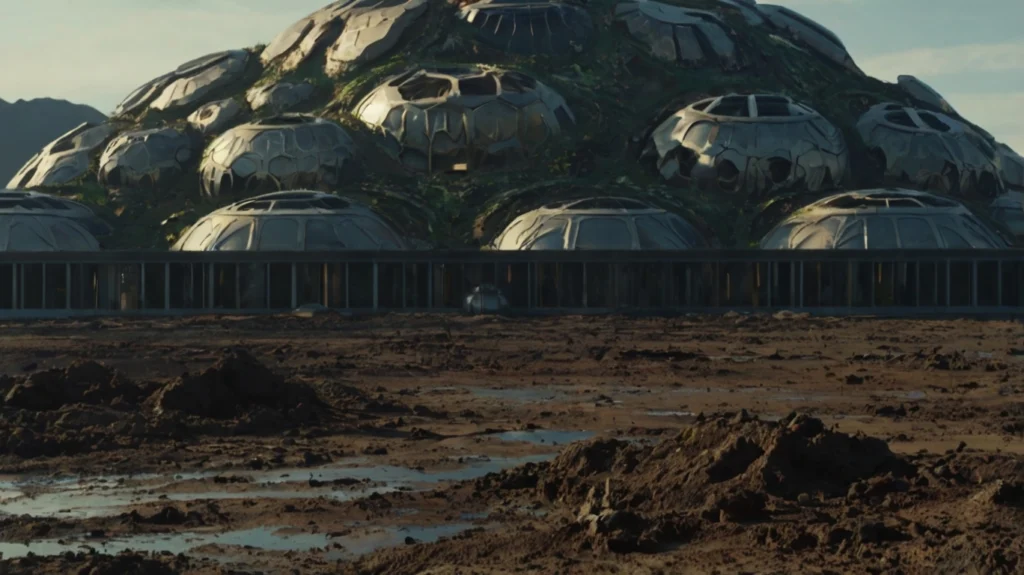Terraforming Earth has become a radical yet promising concept as scientists and environmentalists search for innovative solutions to counter the alarming effects of climate change. The idea is to transform some of the planet’s most hostile environments—like deserts and tundras—into green, productive regions. Imagine deserts covered with thriving forests or the frozen Arctic tundra supporting plant life, both helping to absorb carbon dioxide and reduce global warming.
Terraforming Earth could be key to reversing climate change and transforming hostile environments into thriving ecosystems.
Dr. Jane Smith, Climate Scientist
But how feasible is this vision? Let’s explore recent advancements, real-world projects, and the potential benefits and challenges of such ambitious plans.
What is Terraforming?
At its core, terraforming means transforming a landscape to make it more habitable. Although the term originates from science fiction, where humans terraform entire planets, scientists are now investigating ways to apply similar ideas here on Earth. Instead of leaving the planet to settle on Mars, could we “fix” Earth’s extreme environments to make them more livable?

- Geoengineering: This refers to large-scale climate interventions that address global warming. It includes techniques like carbon capture (removing CO₂ from the atmosphere) and solar radiation management (reflecting sunlight to cool the planet).
- Terraforming on Earth: While not as extreme as turning Mars into a second Earth, terraforming on our planet involves transforming uninhabitable areas into fertile landscapes by managing temperature, water availability, and vegetation.
Recent Examples and Advancements in Terraforming Earth’s Harsh Environments
Terraforming Earth isn’t just a futuristic concept—it’s already happening in several parts of the world. Let’s look at a few groundbreaking examples where scientists are working to transform deserts, tundras, and more.
Desert Transformation Projects
- Dubai Desert Forest: In the United Arab Emirates, scientists are experimenting with hydrogel technology to retain water in desert soil. Hydrogels are tiny, sponge-like materials that can absorb large amounts of water, slowly releasing it to help plants grow in arid conditions. This project is an attempt to create “desert forests” that absorb carbon dioxide and bring biodiversity to desert ecosystems.
- The Great Green Wall in Africa: This ambitious project aims to plant an 8,000-kilometer wall of trees across the Sahel region in Africa, stretching from Senegal to Djibouti. This “wall” of greenery will help prevent desertification, restore degraded lands, support local economies, and create millions of jobs. Countries across Africa are collaborating to combat the expanding Sahara Desert, which threatens agriculture and biodiversity.
Transforming the Arctic and Tundra Regions
- Pleistocene Park, Siberia: In Russia’s Arctic tundra, scientists are attempting to recreate the ancient “mammoth steppe” ecosystem by reintroducing large herbivores like bison, horses, and musk oxen. These animals trample the snow, which helps keep the ground colder, thus preventing permafrost from thawing and releasing carbon stored in the ground. It’s a creative way of using nature to protect the permafrost and combat climate change.
- Albedo Modification in the Arctic: Albedo refers to how reflective a surface is. Snow and ice have a high albedo, meaning they reflect most sunlight, keeping temperatures lower. Scientists are experimenting with reflective materials to coat glaciers and prevent them from melting. By maintaining icy surfaces, this approach helps reduce heat absorption, slowing down the warming of the Arctic.
Innovative Urban Solutions: “Living Walls” and Domed Ecosystems
- In many cities around the world, “living walls”—vertical gardens that grow on buildings—are helping absorb CO₂ and reduce urban heat. Imagine scaling up this concept to build massive structures or domes over deserts, which could create isolated, climate-controlled environments where plants can flourish. These futuristic designs are still in their infancy, but architects and environmental engineers are optimistic that they could eventually help transform uninhabitable regions.
Benefits of Terraforming Earth’s Extreme Environments
Terraforming Earth offers a range of benefits, from combating climate change to supporting economic growth and biodiversity. Here are some of the most significant potential advantages:

Combating Climate Change
By turning barren areas into green ecosystems, terraforming projects can act as carbon sinks. Forests, grasslands, and wetlands naturally absorb CO₂, and expanding these ecosystems could help reduce greenhouse gases in the atmosphere. In addition, restored ecosystems such as mangroves, which sequester large amounts of carbon, could provide a significant reduction in global carbon emissions. The more we restore these ecosystems, the closer we move toward achieving climate goals and reducing the effects of global warming.
Creating New Habitable Lands
As climate change affects existing cities and agricultural areas, terraforming could offer new spaces for human settlement and farming. If we can transform deserts into fertile lands, we can address food security issues and reduce migration pressures caused by extreme weather patterns and rising sea levels. Cities in areas once considered too arid, such as parts of the Middle East and North Africa, could thrive with the right approach to land management and water use.
Economic and Social Benefits
In Africa, for example, the Great Green Wall is expected to create jobs in agriculture, forestry, and tourism, providing local communities with new income sources and boosting local economies. Other projects, like greening deserts in the UAE, can also inspire eco-tourism, agriculture, and local employment opportunities. These initiatives can provide a much-needed boost to the economies of regions struggling with desertification and land degradation. In addition, they could attract international investment and collaboration, particularly in sectors related to sustainable development and environmental conservation.
Supporting Biodiversity
Terraforming doesn’t only benefit humans; it also creates habitats for animals and plants. In areas where forests or wetlands are reintroduced, biodiversity thrives, contributing to a healthier, more resilient ecosystem. These efforts help protect endangered species by restoring critical habitats that are lost to urbanization or desertification. Additionally, thriving ecosystems serve as vital buffers against extreme weather events, such as floods or droughts, that threaten both wildlife and human populations. Furthermore, by integrating diverse plant species into terraforming projects, we can encourage pollination, improve soil health, and contribute to global agricultural resilience.
Enhancing Water Availability
Another key benefit of terraforming Earth’s extreme environments is the potential to improve water availability. Many terraforming projects, like the greening of deserts, focus on improving water retention in the soil. This allows for more efficient water use in agriculture and can turn previously unusable land into productive farmland. Restoring wetlands or creating artificial lakes in arid areas can also serve as vital sources of freshwater for local communities and ecosystems, helping mitigate the effects of droughts and ensuring a more stable water supply for future generations.
In conclusion, terraforming Earth’s extreme environments offers numerous benefits, not only helping to mitigate climate change but also improving livelihoods, boosting economies, and enhancing biodiversity. While these projects present significant challenges, the long-term rewards could be transformative, leading to a more sustainable, resilient planet.
Challenges and Risks of Terraforming Projects
Terraforming is promising but not without challenges. Here are some of the main obstacles and risks:
Environmental Risks
- Transforming ecosystems isn’t always predictable. For instance, turning deserts into forests might disrupt native species that are adapted to arid conditions. Similarly, changing the tundra ecosystem could release methane, a powerful greenhouse gas, as the permafrost thaws.
Terraforming projects must carefully balance innovation with caution to avoid unintended environmental consequences
Dr. John Doe, Environmental Scientist.
Geopolitical Tensions
- Terraforming projects might lead to territorial disputes, especially in regions like the Arctic, where countries are already competing for resources. If terraforming creates valuable new land, it may lead to disagreements over sovereignty, resource allocation, and access rights.
Ethical Concerns
- Ethical issues are also prominent in terraforming discussions. Transforming certain landscapes could disrupt indigenous communities who have cultural ties to the land. For example, reintroducing animals in the Siberian tundra impacts the traditional livelihoods of the nomadic peoples who live there. Terraforming projects need to consider and respect local cultures and practices.
Future of Terraforming Earth: What’s Next?
As technology advances, the future of terraforming Earth looks both exciting and complex. Here’s what we might expect in the coming years:

Genetically Modified Plants and Animals
- Scientists are already developing genetically modified organisms (GMOs) that can survive extreme conditions. For instance, drought-resistant crops could make farming possible in deserts, while cold-resistant plants could help green the tundra.
Advanced Materials for Extreme Conditions
- Engineers are developing materials that can withstand extreme temperatures and conditions, which could help build climate-controlled structures like domes or living walls over harsh landscapes. These materials could create mini-ecosystems, allowing for precise control over temperature, humidity, and sunlight, making it possible to grow crops in unlikely places.
International Collaboration: Terraforming Alliances
- Given the potential for territorial disputes, some experts suggest forming “terraforming alliances”—international coalitions dedicated to regulating and overseeing these projects. These alliances could establish rules, conduct environmental impact studies, and mediate disputes to ensure that terraforming projects are conducted responsibly and ethically.
Final Thoughts: Could Terraforming Be the Key to a Sustainable Future?
Terraforming Earth presents a hopeful vision of the future, where humanity can overcome climate change by transforming deserts, tundras, and other harsh environments into green, productive spaces. However, while the technology shows promise, it’s essential to approach these projects with caution, considering the environmental, social, and ethical implications.
If successful, terraforming could redefine how we live, making new regions habitable and expanding ecosystems to support biodiversity. Whether it’s through foresting deserts, creating domed cities, or developing resilient plant species, the idea of transforming Earth’s harshest environments represents one of our most ambitious efforts to adapt to a changing planet.
As humanity steps into an era of climate resilience and technological innovation, terraforming Earth might just be the key to a more sustainable, inclusive, and thriving world.
Must Read : The Rise of Biohacked Bodies








